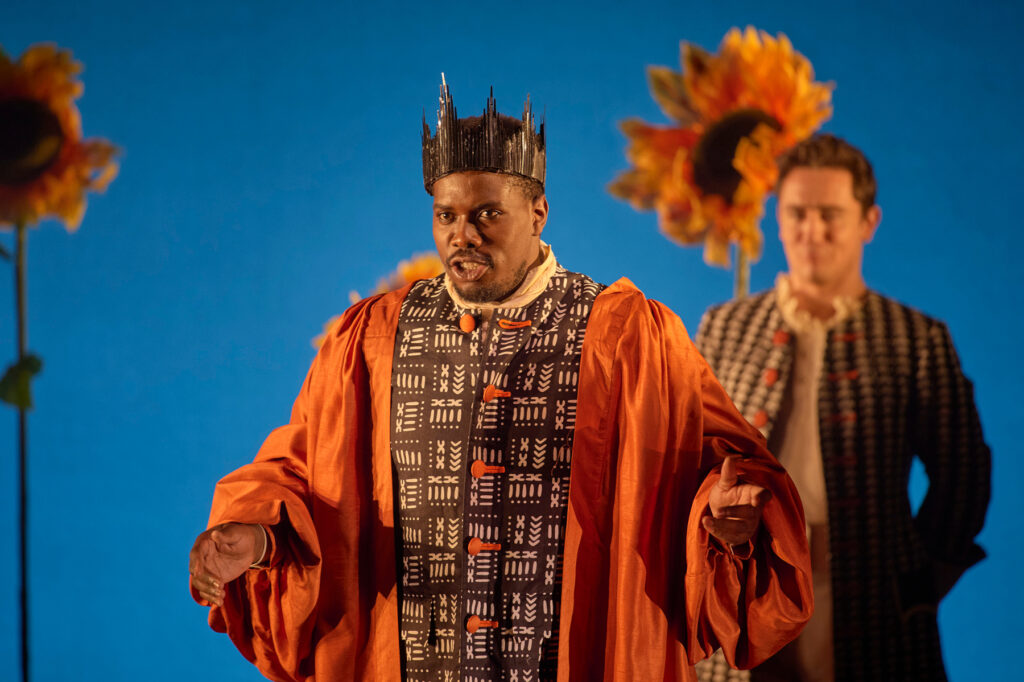For those of us with little or no interest in sport, an Olympics year does at least offer the opportunity for otherwise rarely seen operatic settings of Metastasio’s libretto L’Olimpiade, whose action occurs against the backdrop of those games in Greek antiquity. Like many of his texts, this one was set many times during the course of the 18th century, starting with Caldara in 1733. Vivaldi’s version came almost immediately afterwards, being premiered at Venice in February 1734.
Having brought the same composer’s Bajazet to the Linbury Theatre in 2022, in a compellingly taut, tense production, Irish National Opera now mount L’Olimpiade at the same venue, directed by Daisy Evans. By comparison, this sprawls a little in drawing upon a mixture of aesthetics – Greek pottery for some design patterns and colours (even if the so-called terracotta red comes out more as a glowing, fiery orange) and essentially 18th century costumes but with modern sports shoes and under-garments to remind us of the Olympic games at which King Clistene’s daughter, Aristea, is offered as the prize. An array of sunflowers for a stretch of Act One adds nothing to the typically contorted Baroque operatic plot. But otherwise, the visual and choreographic displays happily prove not to be a distraction on the whole, grounded as it all is upon an effectively simple set of a Greek amphitheatre (again alluding to the cultural origins of this Olympiad) and the unities of Aristotelian theatre, though not slavishly bound by these factors so that it retains a suitable flexibility. Clothes racks and frequent changes of dress draw attention, in good Brechtian fashion, to the inherent fact of the work as a piece of theatre.

Intriguingly it bucks the trend of many operatic productions by not utilising all or most of its theatrical effects in the first half before the interval, but reserves an edgy dramatic sequence for the second part to ratchet up the tension significantly, up to the point where it is revealed that Licida, having sent his athletic friend Megacle to repay a favour and compete for him in the games, and so win the hand of Aristea, is actually Clistene’s long-lost son. That characteristically Metastasian turn of events means that Aristea can wed her beloved Megacle after all, and Argene can be reunited with Licida – a relationship which had earlier been thwarted to Argene’s grief, but which caused Licida then to turn his attentions to Aristea before realising that she is actually his sister.
Evans helpfully interpolates some additional mimed action during the performance to explain the background to the plot, notably during the opening Sinfonia where the abandoning of the infant Licida (when he was Filinto) by Clistene is enacted, because a Delphic prophecy declared that the latter’s own son would cause his death. That prophecy doesn’t come true in the opera, and there is a conventional happy ending with a double marriage. But Evans’s stated aim in interpreting Clistene’s actions as a ‘vicious power battle’ with Aristea, and as a patriarchal interference in the freedom and development of his children doesn’t come off quite so effectively in the production; and if the displacement of his authority could have been a potent metaphor for the fulfilment of that prophecy, Aminta’s brisk taking away of his crown in the concluding coro is a rather weak, throwaway gesture to make that point.

Like the production, the singers tend to be a mixed bag. Countertenor Meili Li is an unqualified success as Licida, with the chiselled, smooth finesse of his singing, above all in his ravishing aria ‘Mentre dormi, Amor fomenti’, as he muses upon his love for Aristea. Owing to illness, Gemma Ní Bhriain only acts the part of his friend, Megacle, on stage, while Maria Schellenberg sings from the pit, her colourful, well-rounded performance making up for the somewhat detached action on stage as Bhriain doesn’t mouth the music and so doesn’t seem fully engaged with the drama.
Chima Sijeqa is vocally weighty as Clistene, although his regular solidness of tone lacks variety and nuance. Alexandra Urquiola’s effusive Aristea provides timbral flair, but her notes somewhat spread and swoop, so that the lines don’t have the complete precision and clarity which Baroque music should have. Rachel Redmond fares noticeably better as Aminta for the litheness of her vocal production, above all in the fine control of her coloratura roulades for the aria in which she uses the typical Baroque metaphor of a storm-tossed boat at sea. Sarah Richmond is a serviceable, if bland, Argene, but Seán Boylan offers contrasting charisma as Clistene’s adviser, Alcandro.
Peter Whelan presides over an energetic performance from the harpsichord with the Irish Baroque Orchestra, heightening tension and momentum with the vivid contrasts they draw from one of Vivaldi’s richest and most varied operatic scores. Additional movements from the composer’s sinfonias for strings give scope for further instrumental élan and one of the brief choruses includes the flashing solo violin displays from an episode in the first movement of the ‘Spring’ Concerto. The performance ably affirms Vivaldi as an idiomatic composer of operas, not quite like any other, and makes one hope that more will come from this company.
Curtis Rogers
L’Olimpiade
Composer: Antonio Vivaldi
Libretto: Pietro Metastasio
Cast and production staff:
Clistene – Chuma Sijeqa; Aristea – Alexandra Urquiola; Argene – Sarah Richmond; Megacle – Maria Schellenberg; Licida – Meili Li; Aminta – Rachel Redmond; Alcandro – Seán Boylan
Director – Daisy Evans; Set and Costume Designer – Molly O’Cathain; Lighting Designer – Jake Wiltshire; Movement Director – Matthew Forbes; Conductor – Peter Whelan, Irish Baroque Orchestra.
Linbury Theatre, Royal Opera House, Covent Garden, London, Monday 13 May 2024
Top Image: Meili Li (Licida) centre.
All photos by Ros Kavanagh.